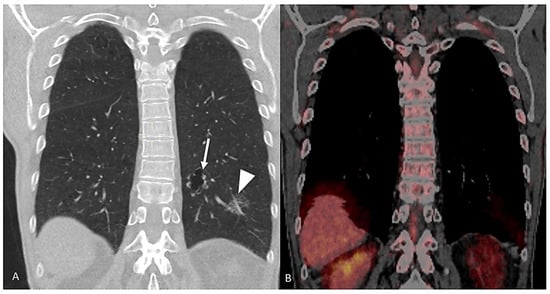Hybrid PET/CT imaging has the advantage of combining functional information with morphological data. The most used PET tracer in oncology is fluorine-18 fluorodeoxyglucose ([18F]FDG), a radiolabeled glucose analogue used to evaluate the increased glucose metabolism in cancers. Evidence-based data have demonstrated that [18F]FDG PET/CT is able to detect the majority of lung cancers due to their increased glucose metabolism with good diagnostic accuracy values [38]. However, the false positive and false negative findings of [18F]FDG PET are well recognized; the first group includes inflammatory/infectious lesions and post-therapeutic changes, while the second group includes non-[18F]FDG avid malignancies (such as low-grade adenocarcinoma or typical carcinoids) due to their slow cell proliferation or poor cellularity. Lung cancers presenting as a ground-glass or part-solid nodule, as consolidation or associated to cystic airspaces, may also present low or no significant [18F]FDG uptake, resulting in low sensitivity of [18F]FDG PET/CT [39]. In particular, the metabolic evaluation of lung cancers associated with cystic airspaces is often limited using [18F]FDG PET/CT since the solid component of these cancers are usually small in size, leading to a frequent pitfall; in other words, these cancers are often misinterpreted as benign due to the lack of significant [18F]FDG uptake [38,40]. Beyond the qualitative (visual) analysis of [18F]FDG PET images, the semi-quantitative analysis using the maximal standardized uptake value (SUVmax), though widely employed, shows the relevant limitations in discriminating among benign and malignant lung cancers (including those with cystic airspaces) [38,40]. Therefore, a SUVmax cut-off to discriminate among benign and malignant lung cancers with cystic airspaces cannot be used in the clinical routine [41]. Conversely, when lung nodules associated with cystic airspaces are incidentally detected by [18F]FDG PET/CT, a 6 month follow-up CT chest examination could be recommended to reassess their morphology and growth [39].
Source link
Clara Valsecchi www.mdpi.com


